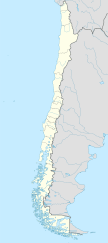Carlos Anwandter Nature Sanctuary facts for kids
Quick facts for kids Carlos Anwandter Nature Sanctuary |
|
|---|---|
|
|
|
IUCN Category IV (Habitat/Species Management Area)
|
|
| Location | Los Ríos Region, Chile |
| Nearest city | Valdivia |
| Area | 4,877 ha (12,050 acres) |
| Designation | Nature sanctuary |
| Designated | 1981 |
| Official name: Río Cruces Chorocamayo Sanctuary | |
| Designated: | 27 July 1981 |
| Reference #: | 222 |
The Carlos Anwandter Nature Sanctuary (also called Santuario de la naturaleza Carlos Anwandter in Spanish) is a special protected wetland. It is located in the Cruces River area, about 15 kilometers north of Valdivia, Chile. This sanctuary is named after Carlos Anwandter, a German politician who moved to Valdivia in 1850.
This important place is a home for many native water birds. About 119 different bird species live here. The most common birds are the beautiful black-necked swans. You can also see many coots.
Even though Chile protected this area in 1981, it became known worldwide later. In 1971, the Ramsar Wetlands Convention recognized its value. This is an international agreement to protect important wetlands. In 2016, a plan was created to manage the sanctuary. Chile's National Forest Corporation (CONAF) made this plan with help from the Ramsar Convention.
An invasive plant called Limnobium laevigatum is also found in the sanctuary. Invasive means it's not native and can harm the local environment.
Contents
Black-Necked Swan Population Changes
The Carlos Anwandter Nature Sanctuary is famous for its black-necked swans. Over the years, the number of swans has changed.
Swan Counts Over Time
In April 2020, a record number of black-necked swans were counted. There were 21,123 swans living in the sanctuary. This was a very high number.
However, in June 2022, something worrying happened. Chile's National Forest Corporation (CONAF) noticed a big drop in the swan population. The number of swans went from 22,419 in 2020 down to only 2,782. During their surveys, CONAF workers found no swan nests or eggs. This meant the swans were not having babies in the sanctuary.
Why Swan Numbers Are Changing
Scientists and experts believe several things might be causing the swan population to drop.
- Predators: The spread of American minks and visits from South American sea lions are thought to harm the swans. These animals can hunt swans and their eggs.
- Human Activities: People using water scooters in the sanctuary can disturb the birds. Also, new buildings and homes being built nearby might affect the swans' habitat.
- Bird Flu: In March 2023, cases of avian influenza (also known as bird flu) were found. This disease can be very dangerous for birds. Because of this, authorities declared a "zoosanitary emergency." This is a special alert to help control animal diseases.
See also
 In Spanish: Santuario de la naturaleza Carlos Anwandter para niños
In Spanish: Santuario de la naturaleza Carlos Anwandter para niños
- Área Costera Protegida Punta Curiñanco
- Oncol Park
- Punucapa
- Urban Wetlands Law


